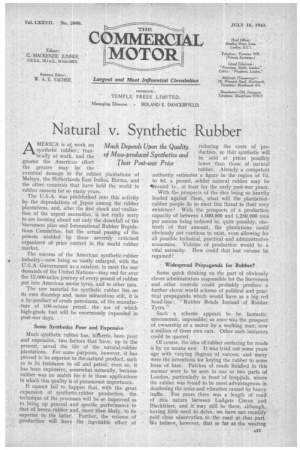Natural v. Synthetic Rubber
Page 15

Page 16

If you've noticed an error in this article please click here to report it so we can fix it.
AMERICA is ati work on synthetic rubber ; frantically at work, and the greater the American effort the greater may be the eventual damage to the rubber plantations of Malaya, the Netherlands East Indies, Burma, and the other countries that have held the world to rubber ransom for so many years.
The U.S.A. was pitchforked into this activity by the depredations of Japan among the rubber plantations, and, after the first shock and-realization of the urgent necessities, is not really sorry to see looming ahead not only the downfall of the Stevenson plan and International Rubber Regulations Committee, but the actual passing of the powers wielded by these severely criticized organizers of price control in the world rubber rmarket.
• The success of the American synthetic-rubber industry—now being so vastly enlarged, with the U.S.A. Government as a catalyst, to meet the war demands of the United Nations—may end for ever the 12,000-miles journey of every pound of rubber put into American motor tyres, and to other uses.
The raw material for synthetic rubber lies on its own doorstep and, more miraculous still, it is a by-product of crude petroleum, of the manufacture of 100-octane petrol, the use of which high-grade fuel will be enormously expanded in. post-war days.
Much Depends of Mass-produc Their Post
Some Synthetics Poor and Expensive Much synthetic rubber has, hitherto, been poor and expensive, two factors that have, up to the present, saved the life of the natural-rubber plantations. For some purposes, however, it has proved to be superior to the-natural product, such as in its resistance to oil and petrol; even so, it has been expensive, somewhat naturally, because rubber was no match for it in those applications in which this quality is of paramount importance.
• It cannot fail to happen that, with the great expansion of synthetic-rubber production, the technique of the, processes will be so improved as to bring up general and specific performance to that of hevea rubber and, more than likely, to be superior to the latter. Further, the volume of production will have the inevitable effect of reducing the costs of pro Auction, so that synthetic will be sold at prices possibly lower than those of natural rubber. Already a competent authority estimates a figure in the region of 7d. to 8d. a pound, .whilst natural rubber ma Y be 4liround Is., at least for the early post-war years.
With the prospects of the dice being so heavily loaded against them,. what will the plantationrubber people do to meet this threat to their very existence? With the prospects of a production capacity of between 1,000,000 and 1,250,000 tons per annum being reduced to, quite possibly, onetenth of that amount, the plantations could obviously not continue to exist, even allowing for all possible technical, practical and administrative economies. Volume of production would be a vital necessity. How could that lost volume be regained?
Widespread PrOpaganda for Rubber?
Some quick thinking on the part of obviously clever administrators responsible for the Stevenson and other controls could probably produce a further clever world scheme of political and practical propaganda which would have as a big red head-line: "Rubber Roads Instead of Rubber Tyres.f' Such a scheme appears to be fantastic, uneconomic, impossible; so oncewas the prospect of ownership of a motor by a working man; now a million of them own cars. Other such instances could be quoted. • • Of course, the idea of rubber surfacing for roads is by no means new. It was tried out some years ago with varying degrees of 'success, and many were the inventions for keying the rubber to some form of base. Patches of roads finished in this manner were to be seen in one or two parts of London, particularly in front of hospitals, where the rubber was found to be most advantageous in deadening the noise and vibration caused by heavy traffic. For years there was a length of road of ;this nature between Ludgate Circus and Blackfriars, and it 'may still be there, although, having little need to drive, we have not recently paid close observation to the road at that part. We believe, however, that so far as the wearing qualities were concerned it made quite a good showing.
With regard to the total elimination of natural rubber, this depends very much upon the eventual qualities of the synthetic products, as apart from their price. The best synthetic so far produced is of a somewhat dry nature. It lacks the quality. of " sticktion " and, consequently, requires at least a reasonable proportion of natural rubber to act as a binding medium between it and .a tyre carcase, or for °tiler purposes where this characteristic is essential. Likewise, natural rubber is used to a considerable extent as latex and, although we may be wrong, we have an idea that the artificial variety could not be so well employed' in this form.
One or two well-known people in the business world of the U.S.A. and Britain have been inclined to scoff at the idea of natural rubber being superseded, and have suggested that there will be room not only for this but for all the varieties of synthetic. We hope that this is not merely wishful thinking, because rubber is one of the most important staple products of Britain overseas, whilst we appear to be doing very little at home to take any part in the competition which there seems every prospect of developing in the synthetic field.




















































